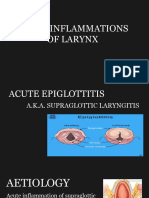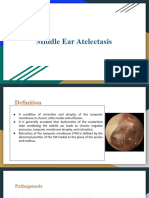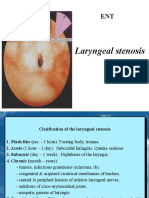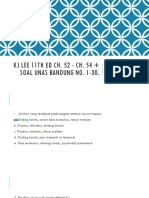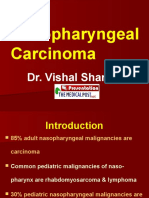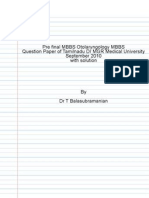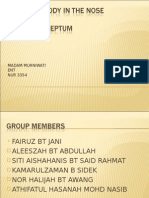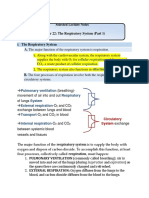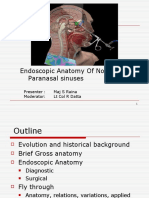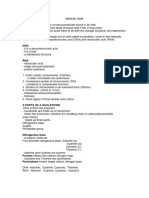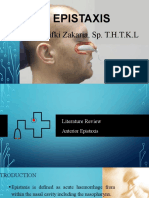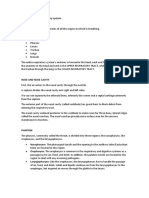Chronic Rhinosinusitis and Nasal Polyps
Chronic Rhinosinusitis and Nasal Polyps
Uploaded by
suriskuCopyright:
Available Formats
Chronic Rhinosinusitis and Nasal Polyps
Chronic Rhinosinusitis and Nasal Polyps
Uploaded by
suriskuOriginal Description:
Copyright
Available Formats
Share this document
Did you find this document useful?
Is this content inappropriate?
Copyright:
Available Formats
Chronic Rhinosinusitis and Nasal Polyps
Chronic Rhinosinusitis and Nasal Polyps
Uploaded by
suriskuCopyright:
Available Formats
Chronic Rhinosinusitis and Nasal Polyps
PATHOGENESIS
A polyp is an oedematous mucous membrane which forms a pedunculating process with
a slim or broad stalk or base. Nasal polyps originate in the upper part of the nose around
the openings to the ethmoidal sinuses.
The polyps extend into the nasal cavity from the middle meatus, resulting in nasal
blockage and restricted airflow to the olfactory region. The polyp stroma is highly
oedematous with a varying density of inflammatory cells.
Nasal polyposis, consisting of recurrent, multiple polyps, is part of an inflammatory reaction
involving the mucous membrane of the nose, paranasal sinuses, and often the lower airways
Several pathogenetic theories on the formation of nasal polyps have been published and these
theories are based on oedema, an increase in tubulo-alveolar glands, the presence of the cysts of
mucous glands and on mucous glands of nasal polyps.
THEORY OF EPITHELIAL RUPTURE
Inflammation and Tissue oedema Epithelial rupture prolapse of Lamina propria
Adjacent epithelium tries to cover up the defect forming lining of polypoidal tissue If not
covered up fast lamina propria continues to grow leading to polyp formation.
Other theories include :
1. Adenoma theory of Billroth
2. Fibroma theory of Hoppman
3. Necrotising Ethmoiditis theory of Woakes
4. Glandular Cystic Theory
5. Glandular Hyperplasia Theory (Krajina)
6. Mucosal Exudate Theory of Hayek
7. Blockade theory of Jenkins
8. Periphlebitis and perilymphangitis theory (Eggston and Wolff)
9. Proetz theory (for antrocoanal polyp)
10. Bernoulli's phenomenon
11. Mucopolysaccharide changes
12. Mill's theory
13. Ewing's theory
14. Infections
15. Vasomotor imbalance theory
ADENOMA FIBROMA THEORY OF BILLROTH
Interpreted nasal polyp to be adenomas that began growing under the nasal mucosa pushing the
epithelium and nasal glands outwards.However Hopmann disagreed with this hypothesis saying
that the glandular tissue found in the tissuesamples of nasal polypi studied contained only
mucous glands normally found in the nasal mucosaand concluded that nasal polypi could be soft
fibromas and used the term fibroma theory to explainthis.These two theories are not currently
accepted at present.
NECROTIZING ETHMOIDITIS THEORY OF WOAKES
This theory suggests that ethmoiditis causes periostitis and ostitis of ethmoid bone causing bone
necrosis. The necrotic bone initiates mucosal reaction leading on to mucosal oedema and polyp
formation.This theory has been flawed from the very begining as no evidence of bone necrosis
could be found in the polypoidal tissue studied so far.
TAYLORs GLANDULAR CYST THEORY
Evidently this theory is based on the presence of cystic glands and mucous filled cysts in the
nasal
polypoid tissue.The probable cause for the formation of these glandular cysts could be oedema of
submucosa causingobstruction to the drainage of mucoid glands present in the nasal
mucosa.These mucous cysts expands outwards pushing the nasal mucosa causing the polyp to
occur.
Taylor in his meticulous study has proved that mucous glandular cysts usually occur after the
polyp has formed and hence he believed that glandular cysts could be caused by nasal polyposis
and not vice versa.
MUCOSAL EXUDATE THEORY OF HAYEK
Hayek believed that nasal polyp formed due to accumulation of exudate localised deep in the
mucosa.This accumulation of exudate causes the mucosa to bulge leading to polyp
formation.Nasal mucosal glands and tubuloalveolar glands are also displaced outwards. These
glands are hence found in the distal part of the polyp.
BLOCKADE THEORY OF JENKINS
This theory is based on the premise that development of nasal polypi is almost always preceded
by certain degree of nasal mucosal inflammation. The inflammation could be the result of either
infection / allergy. Histologically polyp itself is accumulation of intracellular fluid dammed up in
a localized tissue.If this blockage persists polyp develop, if the blockage covers a large area then
multiple polypi forms. This theory doesnt explain why nasal polyp prefers certain areas of nasal
cavity.
PERIPHLEBITIS / PERILYMPHANGITIS THEORY OF EGGSTON AND WOLFF
This theory is based on the premise that recurrent infections of nasal mucosa blocks intercellular
fluid transport mechanism in the mucosa. This is always associated with oedema of lamina
propria. This theory is based on the demonstration of chronic vascular changes in the nasal
mucosa in response to inflammation. Histologically these changes are supposed to be rather
diffuse and hence cannot be used to explain the pathogenesis of nasal polypi which can always
be localised to certain areas of nasal cavity.
GLANDULAR HYPERPLASIA THEORY OF KRAJINA
According to Krajina chronic inflammation of nasal mucosa cause local hyperplasia of nasal
mucosal glands.These hyperplastic glands will cause bulging of nasal mucosa. In addition to
glandular hyperplasia changes that occur in the blood vessels will cause oedema in the region of
the middle meatus. This in turn increases nasal mucosal oedema. Studies have shown that the
number of nasal mucosal glands are the same in polypoidal as in the normal tissue.
PROETZ THEORY FOR DEVELOPMENT OF ANTROCOANAL POLYP
Proetz suggested that this disease could be due to faulty development of the maxillary sinus
ostium, since it was always been found to be large in these patients. Hypertrophic mucosa of
maxillary antrum sprouts out through this enlarged maxillary sinus ostium to get into the nasal
cavity. The growth of the polyp is due to impediment to the venous return from the polyp.
This impediment occur at the level of the maxillary sinus ostium. This venous stasis increases the
oedema of the polypoid mucosa thereby increasing its size.
BERNOULLI'S PHENOMENON
Pressure drop next to a constriction causes a suction effect pulling the sinus mucosa into the
nose.
MUCOPOLYSACCHARIDE CHANGES
Jakson postulated that changes in mucopolysaccharides of the ground substance could cause
polyp
MILL'S THEORY
Mills postulated that antrochonal polyp could be maxillary mucoceles which could be caused due
to obstruction of mucinous glands
EWING'S THEORY
Ewings suggested that an anomaly which could occur during maxillary sinus development could
leave a mucosal fold close to the ostium. This fold could later be aspirated into the sinus cavity
due to the effects of inspired air causing the development of antrochonal polyp.
INFECTIONS
VASOMOTOR IMBALANCE THEORY
Why Osteomeatal area is Most commonly affected during Polyp
Formation ?
Osteomeatal complex is most common site of development of polyp. It is proposed that
'Touching mucous membranes' in the narrow ostiomeatal complex results in the release of pro
inflammatory cytokines from epithelial cells. Another possibility is an influence of special
airflow, air current and pressure in the upper part of the nose i.e. Bernaullis phenomenon.
Finally, it may be of significance that the nerve endings near the borderline between the nose and
paranasal sinuses are thin and may easily become damaged by cytotoxic proteins, released by
eosinophils.
Cellular Infiltration
o Eosinophilic inflammation is an important feature in the pathogenesis of chronic
Rhinosinusitis (CRS) with nasal polyps.
o The eosinophilic accumulation in the polyp stroma is basically caused by increased
transendothelial migration and increased survival time in the tissue, where an increased
concentration of interleukine 5 (IL-5) plays a major role.
o The increased amount of IL-5 is predominantly released from T-lymphocytes,
independently of atopy, and the highest concentration has been found in polyps from
patients with non-allergic asthma and acetylsalicylic acid (ASA) intolerance.
o These are the sub-groups of patients also known to exhibit the greatest accumulation of
eosinophils .
At the beginning , mucosal edema found that most are in the meatus medius then filled by a fluid
stroma intercellular and the swollen mucosa becomes polipoid . If the process continues, the
swollen mucosa will grow bigger and then going down into the nasal cavity while forming stalk
so formed polip.
Polyps in nasal cavum formed by a long process of inflammation and the most common causes
are chronic sinusitis and allergic rhinitis. The prolonged vasodilation of blood vessels in
submukosal layer cause mucosal edema and the mucosa will be become more irreguler and
pushed to nearby sinus , eventually form a structure called a polyp . Usually occurs in maxillary
sinus , and sinus etmoid . The developed polyps will grow in antrum and move to nasal cavum.
This is because recurrent sneezing and secretion production often experienced by people who
have a history of perennial allergic rhinitis due to no variation in seasons and exposed to
allergens throughout the year . Once the polyp reached the nasal cavum it will cause nasal
obstruction as it grows.
References
1. Mangunkusumo,Endang dan Retno S. Wardani. 2007. Polip Hidung. Buku Ajar Ilmu
Kesehatan Telinga, Hidung, Tenggorok, Kepala dan Leher edisi VI. Jakarta: Balai Penerbit
FKUI. Hal. 123-5.
2. Mansjoer,Arif,Kuspuji Triyanti,Rakhmi Savitri, dkk. 2001. Polip Hidung. Kapita Selekta
Kedikteran ed.III jilid 1. Jakarta: Media Aesculapius FKUI. Hal: 113-4.
3. Darusman, Raisa Kianti. 2002. Polip Hidung. Available at www.geocities.ws, accessed on
February 12th, 2012.
4. Mercy. 2008. Polip Nasi. Available at mercywords.blogspot.com , accessed on February 12th,
2012.
5. Soetjipto, Damayanti dan Retno Wardani. 2008. Hidung. Buku Ajar Ilmu Kesehatan Telinga,
Hidung, Tenggorok, Kepala dan Leher edisi VI. Jakarta: Balai Penerbit FKUI. Hal:118-22.
6. Aminy, Uyunk. 2011. Polip Hidung. Available at http://luv4all.wordpress.com/2011/03,
accessed on February 12th, 2012.
7. Adams, George, Lawrence Boies and Peter Hiegler. 1997. Rhinosinusitis Alergika. Buku Ajar
Penyakit Telinga Hidung Tenggorok ed.VI. Philadelphia: W.B. Saunders. Hal.210-217.
8. Perhimpunan Dokter Spesialis THT-KL Indonesia (PERHATI-KL). 2007. Polip Hidung dan
Sinus Paranasal (Dewasa) Penatalaksanaan. Guideline Penyakit THT di Indonesia. Hal.58.
9. Fokkens W, Lund V, Mullol J, European Position Paper on Rhinosinusitis and Nasal Polyps
group. European position paper on rhinosinusitis and nasal polyps 2007. Rhinol Suppl. 2007
1-136. PubMed PMID: 17844873.
You might also like
- Eustachian Tube: Structure, Function, and Role in Middle-Ear Disease, 2eFrom EverandEustachian Tube: Structure, Function, and Role in Middle-Ear Disease, 2eNo ratings yet
- Maxillary Carcinoma, Nasal Cavity and Paranasal Sinus Malignancy PDFDocument18 pagesMaxillary Carcinoma, Nasal Cavity and Paranasal Sinus Malignancy PDFSuprit Sn100% (2)
- Medial and Lateral Pterygoid Plates: Periapical Film A) MaxillaDocument25 pagesMedial and Lateral Pterygoid Plates: Periapical Film A) MaxillaPayal JainNo ratings yet
- Nursing Management of Patient With Disorders of Ent Third YrDocument26 pagesNursing Management of Patient With Disorders of Ent Third YrShreyas Walvekar100% (4)
- Growth and Development of Maxilla / Orthodontic Courses by Indian Dental AcademyDocument63 pagesGrowth and Development of Maxilla / Orthodontic Courses by Indian Dental Academyindian dental academy100% (1)
- Otitis Media With EffusionDocument3 pagesOtitis Media With EffusionAnish RajNo ratings yet
- Nasal PolypDocument10 pagesNasal PolypHetvi ParmarNo ratings yet
- Nasal PolypDocument26 pagesNasal PolypVajja SwatiNo ratings yet
- By (PG in ENT) : DR B.SowmyaDocument87 pagesBy (PG in ENT) : DR B.Sowmyadrchinna100% (1)
- Larynx InfectionsDocument28 pagesLarynx InfectionsMuskan Gogia100% (1)
- Cholesteatoma Congenital, PediatricDocument6 pagesCholesteatoma Congenital, PediatricMeilina Elin WardhaniNo ratings yet
- Keratosis ObturansDocument12 pagesKeratosis ObturansRahma LuthfaNo ratings yet
- Throat Pharynx Palatine Tonsils ENT LecturesDocument45 pagesThroat Pharynx Palatine Tonsils ENT Lecturessankarsuper83No ratings yet
- OtomycosisDocument10 pagesOtomycosisMichael SihombingNo ratings yet
- Physiology of Nose & P.N.S.: Dr. Vishal SharmaDocument54 pagesPhysiology of Nose & P.N.S.: Dr. Vishal SharmaE=MC2No ratings yet
- Chronic RhinosinusitisDocument36 pagesChronic RhinosinusitisAritro BhattacharjiNo ratings yet
- Otitis Media With EffusionDocument46 pagesOtitis Media With EffusionSheBy Irawan100% (1)
- Approach To The Adult With EpistaxisDocument18 pagesApproach To The Adult With EpistaxisTP RMad100% (1)
- AtelektasisDocument15 pagesAtelektasisMuhammad Ade RahmanNo ratings yet
- Sailedinitis PDFDocument8 pagesSailedinitis PDFNavatha MorthaNo ratings yet
- Intratympanic Steroid TherapyDocument2 pagesIntratympanic Steroid TherapyKai Siang TayNo ratings yet
- Orbital Decompression, Optic N Decompression and EndoDCRDocument97 pagesOrbital Decompression, Optic N Decompression and EndoDCRAlok RathiNo ratings yet
- Tenggorokan - Vocal NodulDocument3 pagesTenggorokan - Vocal NodulindahNo ratings yet
- OSMFDocument20 pagesOSMFAl RawdhaNo ratings yet
- Temp Bone Trauma Slides 051012Document55 pagesTemp Bone Trauma Slides 051012RaihanFarhanaNo ratings yet
- OJOLNS-10 - II - Interlay Myringoplasty PDFDocument7 pagesOJOLNS-10 - II - Interlay Myringoplasty PDFAnonymous ST1Ot2GAHx100% (1)
- Anatomy NoseDocument35 pagesAnatomy Noseضبيان فرحانNo ratings yet
- Cranial Nerve ExaminationDocument46 pagesCranial Nerve Examination966342No ratings yet
- JnaDocument34 pagesJnaDeepak KumarNo ratings yet
- Rinitis Alergi Dan VasomotorDocument26 pagesRinitis Alergi Dan VasomotorMardoni EfrijonNo ratings yet
- Drtbalu'S Otolaryngology Online: TracheomalaciaDocument3 pagesDrtbalu'S Otolaryngology Online: TracheomalaciaAnish RajNo ratings yet
- Cholesteatoma FinalDocument56 pagesCholesteatoma FinalDr.Bharathi M.BNo ratings yet
- OtomycosisDocument18 pagesOtomycosisaku arthanaNo ratings yet
- Management of Congenital Aural AtresiaDocument22 pagesManagement of Congenital Aural AtresiamelaniNo ratings yet
- Antral WashDocument19 pagesAntral WashRavi Bhushan SinghNo ratings yet
- Physiology of Nose & PNSDocument22 pagesPhysiology of Nose & PNSSworupKhadkaNo ratings yet
- Name: Bhanderi Akashkumar H. Clinical Clerk BCCM. ROTATION: OCT. 11-20, 2020Document7 pagesName: Bhanderi Akashkumar H. Clinical Clerk BCCM. ROTATION: OCT. 11-20, 2020Venkatesh GarikapatiNo ratings yet
- Medicine Decoded - Eponymous Signs in ENTDocument26 pagesMedicine Decoded - Eponymous Signs in ENTlokeshNo ratings yet
- Eponymous Signs in ENTDocument11 pagesEponymous Signs in ENTDrTarek Mahmoud Abo KammerNo ratings yet
- Olfactory PathwayDocument20 pagesOlfactory PathwayAsad OsmanNo ratings yet
- Full Download Key Topics in Otolaryngology 2nd Edition N. J. Roland PDFDocument84 pagesFull Download Key Topics in Otolaryngology 2nd Edition N. J. Roland PDFhwydajouan100% (2)
- Stenosis, Scleroma, TracheostomyDocument22 pagesStenosis, Scleroma, Tracheostomysimi yNo ratings yet
- Rhinorrhea DefinitionDocument4 pagesRhinorrhea DefinitionNirmalaQuinnNo ratings yet
- SINUS DentogenDocument24 pagesSINUS DentogenRadityaRezhaNo ratings yet
- A Case Report On - A Rare Case of Laryngocele in A Young Male MenDocument4 pagesA Case Report On - A Rare Case of Laryngocele in A Young Male MenIOSRjournalNo ratings yet
- Acute Laryngitis: Li SGD 21 LBM 5Document40 pagesAcute Laryngitis: Li SGD 21 LBM 511juni09No ratings yet
- Tonsillitis & TonsillectomyDocument18 pagesTonsillitis & TonsillectomyLuqman HakimNo ratings yet
- AuriculoplastyDocument60 pagesAuriculoplastyRadianNasution100% (2)
- A Large Rhinolith and Importance of Nasal Endoscopy: A Case ReportDocument3 pagesA Large Rhinolith and Importance of Nasal Endoscopy: A Case ReportIOSRjournalNo ratings yet
- Pharyngeal Arches and Its DerivativesDocument57 pagesPharyngeal Arches and Its DerivativesDr Toqeer AhmedNo ratings yet
- KJ Lee 11th Ed CH SyarahDocument31 pagesKJ Lee 11th Ed CH Syarahgoblok goblokinNo ratings yet
- Otoacoustic Emissions From MedscapeDocument5 pagesOtoacoustic Emissions From MedscapeMin-Joo Esther ParkNo ratings yet
- #Acute & Chronic Otitis MediaDocument3 pages#Acute & Chronic Otitis MediaameerabestNo ratings yet
- 9-Nasopharyngeal-Carcinoma (1) .PPSXDocument46 pages9-Nasopharyngeal-Carcinoma (1) .PPSXAnin Darayani AyubNo ratings yet
- Anatomi Dan Fisiologi TelingaDocument67 pagesAnatomi Dan Fisiologi TelingaDANDYNo ratings yet
- Lecture 1 Ent.Document60 pagesLecture 1 Ent.kiprotich weldon100% (1)
- Epos Summary PDFDocument30 pagesEpos Summary PDFPutri Rizky AmaliaNo ratings yet
- LPR by Dr. SS NayyarDocument45 pagesLPR by Dr. SS NayyarSuprit Sn100% (1)
- Ent PPT On Pharyngeal AbscessDocument20 pagesEnt PPT On Pharyngeal AbscessDocwocNo ratings yet
- Referat Tumor NasalDocument31 pagesReferat Tumor NasalLydiaKainamaaNo ratings yet
- Csom - Squamosal Type AnilaDocument80 pagesCsom - Squamosal Type AnilaThimmaiah Srirangapura100% (1)
- MGR Medical University Prefinal ENT Sep 2010 Question Paper With SolutionDocument31 pagesMGR Medical University Prefinal ENT Sep 2010 Question Paper With SolutionDr. T. BalasubramanianNo ratings yet
- Upper Nasal Cavity and Chest WallDocument18 pagesUpper Nasal Cavity and Chest WallHessa AlamiraNo ratings yet
- Role of Imaging in RhinologyDocument223 pagesRole of Imaging in RhinologyDr. T. Balasubramanian100% (2)
- Anatomy and PhysiologyDocument7 pagesAnatomy and PhysiologyBlessyl Mae EstenzoNo ratings yet
- UncinateDocument10 pagesUncinateRoshni KNo ratings yet
- Lec.3 Development of The FaceDocument25 pagesLec.3 Development of The FaceDentistryNo ratings yet
- Foreign Body in The NoseDocument32 pagesForeign Body in The NoseLady350zNo ratings yet
- Chapter 22 Notes Respiratory SystemDocument36 pagesChapter 22 Notes Respiratory SystemMarilia BonorinoNo ratings yet
- The-Skull by Dr. Phan SandethDocument65 pagesThe-Skull by Dr. Phan SandethTith Sunny100% (2)
- Endoscopic Anatomy of Nose and PNS FinalDocument98 pagesEndoscopic Anatomy of Nose and PNS FinalRahul Kurkure100% (2)
- Anat102a Notes FinalsDocument12 pagesAnat102a Notes FinalsJianne PulidoNo ratings yet
- Case Report Dr. Frenky RSKDocument12 pagesCase Report Dr. Frenky RSKTHT KLNo ratings yet
- Science 9 Q1Document7 pagesScience 9 Q1MADELYN QUIMBONo ratings yet
- EPISTAXIS - RifkiDocument21 pagesEPISTAXIS - RifkiIta Aprilia SaktiNo ratings yet
- Choanal AtresiaDocument4 pagesChoanal AtresiaAshitha S KabeerNo ratings yet
- Anatomy Study OutlineDocument32 pagesAnatomy Study OutlineJustine Val RevalidaNo ratings yet
- San Beda Respiratory System 9-15Document68 pagesSan Beda Respiratory System 9-15conyxzNo ratings yet
- Anatomy of The Respiratory SystemDocument3 pagesAnatomy of The Respiratory SystemBritany ReyesNo ratings yet
- Practice 2-M12Document4 pagesPractice 2-M12Châu Nguyễn NgọcNo ratings yet
- Infratrochlear Nerve BlockDocument8 pagesInfratrochlear Nerve Blockudayraj_vNo ratings yet
- Nasal Cauterization With Silver Nitrate For Recurrent EpistaxisDocument3 pagesNasal Cauterization With Silver Nitrate For Recurrent EpistaxisJorge SánchezNo ratings yet
- Antral Puncture and LavageDocument9 pagesAntral Puncture and Lavagesimi yNo ratings yet
- Dr. Eugene Kerns Lecture On Empty Nose SyndromeDocument6 pagesDr. Eugene Kerns Lecture On Empty Nose SyndromeMa Luisa MuroNo ratings yet
- SkullDocument3 pagesSkullbryana legaspiNo ratings yet
- Chapter 35: Respiratory Tract Patton: Anatomy and Physiology, 10th EditionDocument28 pagesChapter 35: Respiratory Tract Patton: Anatomy and Physiology, 10th EditionLoretta FergusonNo ratings yet
- Anatomy of The Respiratory System: Dersi Sayfa Sayfa Türkçe Dinleyin!Document9 pagesAnatomy of The Respiratory System: Dersi Sayfa Sayfa Türkçe Dinleyin!fsdgNo ratings yet
- EntDocument11 pagesEntkhuzaima9No ratings yet
- Arteries of The Head and NeckDocument23 pagesArteries of The Head and NeckFatima Kh SalahNo ratings yet









